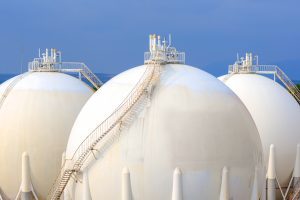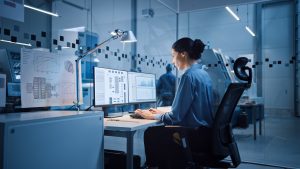This audio was created using Microsoft Azure Speech Services
Most likely you already know that Virtual Reality (VR) and Augmented Reality (AR) are rapidly evolving and growing technologies. They utilize the latest high powered computers and graphics cards to simulate real or imaginary environments and situations with a high degree of realism and interactivity. This is great for gaming and other fun applications, but did you also know that it’s already being adopted broadly by the process and manufacturing industries to bring value to the workplace?
Virtual Reality has also been applied in a wide range of other areas – like assisting in the visualization of complex data, robot control and remote operation of equipment. It’s also extremely impactful in virtual prototyping and design, HAZOP analysis and most importantly — plant crew training. The success of those applications has relied heavily on a realistic virtual environment which can today be created in a very cost effective manner.
Plant Crew Training
Today, Gamers (adults and kids) spend time playing their 3D games, and after a period of time become familiar with all the characters of the game. They learn how they should interact with these characters and repeatedly navigate the layout of the virtual environment until they know their way around. And they learn how to “win” by successfully performing whatever tasks are set by the game designers.
And also today, the process industries are using gaming technologies to create Virtual Reality replicas of real world production facilities. This virtual world is then being used as an Immersive Training Simulator (ITS), which allows field operators to interact with the virtual world using game controllers and 3D headsets or televisions. It is similar to how a Control Room Operator interacts with an Operator Training Simulator through the trainee control panel or console.
Some key differences between “games” and industrial applications include:
- the environment where the trainee “plays” is the actual plant
- the characters are their colleagues in the field and the control room staff, and
- their tasks to “win” are standard and non-routine operating procedures
Schneider Electric has integrated their Immersive Training Simulator technology, EYESIM, with their Operator Training Simulator (OTS) technology, DYNSIM, to create an environment that facilitates entire plant crew training in a realistic manner, yet in a completely safe environment.
The entire plant crew can perform all the Standard Operating Procedures required to startup or shutdown a plant include operations by the panel operator and manual operations on field devices (e.g. opening manual valve) by the field operations staff. These actions must be coordinated and executed in the correct sequence and in a timely manner. The integrated OTS and ITS allows the crew to work together and step through all the procedures.
Practice, Practice, Practice
Entire plant crews, some operating the OTS control panel and others out in the Virtual field must communicate and cooperate in order to execute a flawless startup or shutdown. They won’t get it right the first time, nor the second time, but the consequences of a team’s correct and incorrect decisions are sent immediately back to the trainees — giving them the opportunity to directly learn from their mistakes. They can practice, practice and practice until they are nearly perfect and the entire startup procedure become second nature for the entire plant crew before they undertake it for real, in the plant.
Industries such as oil and gas, refining and power companies must institutionalize their workforce knowledge in efficient and effective ways. Leveraging VR models and OTS to improve time-to-competency in critical areas such as safety and environment protection systems is a must-do. It is not simply ‘just an idea’ if a company wants to achieve its goals of true operational excellence.
KOC Trains Successful Operators
Take a look at how one company has embraced this progressive VR technology to solve problems, maximize its resources and improve operations. Kuwait Oil Company (KOC) deployed an integrated operator and Immersive Training Simulator from SimSci by Schneider Electric to achieve operational excellence at their facility. Watch the video now.
Lifecycle Management
After this fourth blog, in a series of five, I hope that a very clear picture is developing in your mind about the many benefits can be realized through the use of dynamic simulation throughout the process lifecycle.
- Savings can be realized early in the design phase of a project with capital and operating cost optimization.
- Further savings can be realized by pre-commissioning the plant controls thereby minimizing live plant commissioning time and allowing your company to start producing revenue and profit sooner. Operating plants are then safer, and more profitable because the control room staff have been efficiently trained and are now operating at a higher level of competency.
- This fourth blog has gone outside the control room to show how contemporary technology (virtual reality training) can benefit control room and field operations staff enabling entire plant crew training.
 Please read the next and final blog in the series to learn how dynamic simulation can be applied at every level of the enterprise through the use of scenario based e-learning initiatives enabled by the SimSci Training Academy. If this is the first blog you are reading in the series, I would recommend taking a look back at the previous blogs beginning with:
Please read the next and final blog in the series to learn how dynamic simulation can be applied at every level of the enterprise through the use of scenario based e-learning initiatives enabled by the SimSci Training Academy. If this is the first blog you are reading in the series, I would recommend taking a look back at the previous blogs beginning with:
Blog #1: What Good is the Eiffel Tower in the Middle of your Refinery?
Blog #2: Controls Pre-commissioning Is Like Checking your Parachute Before Jumping…A Very Wise Decision.
Blog #3: To Err is Human, to Have the Safest Operators is Divine – OTS
If you are interested in learning more about Workforce Optimization solutions, including operator training simulators and EYESIM for you and your crew, download our free whitepaper or contact us today!



